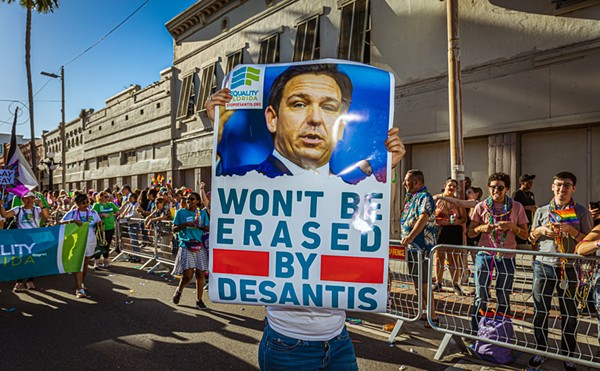A few years ago, Creative Loafing ran a Must-Do List of "100 things you gotta do to be a true resident of Tampa Bay." You could check off the things you'd done, note the things you hadn't and rate your overall Tampa Bay-ness. The list below — "100 ways to go green right now" — wasn't meant to be a sequel, but it occurs to me that this is the real Must-Do List. These aren't casual suggestions, as in, "Oh you must try that restaurant." These are imperatives for the planet — 100 things you gotta do to be a responsible resident of the world.
It's "Do these things — or else."
And therein lies the problem with Going Green. In reading through these 100 items, I feel a combination of excitement and exhaustion: excitement at the possibility of making a difference, but exhaustion at the prospect of trying to accomplish even half of what's on the list — a feeling compounded by the glut of green marketing, green movies, green slogans, green backlash.
These conflicting emotions plague a lot of us these days, I suspect. In a related story in our Green Issue, CL 's Wayne Garcia runs through some of the political factors that stand in the way of green initiatives. One of the problems with talking about green is that there have been unintended consequences — deforestation due to ethanol production and poisonous mercury in those new fluorescent bulbs, as our writer Wade Tatangelo details with a healthy dose of eco-skepticism. (Yes, he even questions global warming. Go ahead, argue with him.) There will likely be more such screw-ups as we stumble toward a goal of reducing our American consumption, the highest and most wasteful in the world.
So I understand, believe me, that as Earth Day approaches, the very mention of 'going green' may have already sent you away screaming.
And yet. Look over the list. Some of the suggestions are easily adaptable (#80: Bring your own mug), some downright challenging (#33: Build a solar oven). Some may make you wonder, "Why didn't I think of that?" (#24: Shade your air conditioner), and some may make you ask, "Who are you kidding?" (The writer who recommends siphoning gas off Hummers is kidding — I think. But not the one who suggests, "Don't have kids!")
Try them out. See which ones work for you, and score yourself from 1-100 (Carbon Footprick or Green Freak?). Please comment on our list and tell us what you've tried, and what we've missed. Check out our guide to upcoming green events. And if you'd like continue the conversation even further, check out the 'Living Green' section of our blog, fixitnowtampabay.com.
Yes, all this wearing of the green can get a little, well, wearing. But a fresh idea or two might be just the thing to get you into the spirit of the season. —David Warner
Get the information
1. Understand exactly what "sustainable consumption" means. Here's one good definition, from the United Nations: "Sustainable consumption is the use of goods and services that respond to basic needs and bring a better quality of life, while minimizing the use of natural resources, toxic materials and emissions of waste and pollutants over the life cycle, so as not to jeopardize the needs of future generations." UN CSD International Work Programme adopted in 1995.
2. Calculate your carbon footprint. Exactly how accurate carbon footprint calculations are (as they attempt to quantify how your lifestyle and consumer choices impact the environment in a quantifiable way) is the subject of much debate. The real value is getting you to think in terms of your consumer choices. One online calculator is at conservation.org/act/live_green/carboncalc/Pages/default.aspx.
3. Embrace Treehugger. We're talking about the website, treehugger.com, an invaluable resource for green ideas. But getting to know an actual treehugger would probably be edifying, too.
4. Stop reading print newspapers and magazines. Self-defeating? Sure. But "dead-tree-media" has a bunch of impacts, from deforestation for the paper to energy for the production to gas for transportation, not to mention the chemicals that go into paper treatments and ink. The Magazine Paper Project estimates that of the 12 billion magazines produced each year, 95 percent have no recycled content. Read the Web — it uses less energy and kills fewer trees.
5. Or keep reading print newspapers and magazines, but do this, too: Don't feel guilty just because you love the feel of paper between your fingers when you read books or magazines or newspapers the old-fashioned way. Eco-Libris balances your deforesting ways by planting trees in developing countries with your financial help. In Tampa Bay, Eco-Libris is partnered with Inkwood Books, where $1 will get you a new tree in a distant land. Ecolibris.net; Inkwood Books, 216 S. Armenia Ave., Tampa, inkwoodbooks.com.















